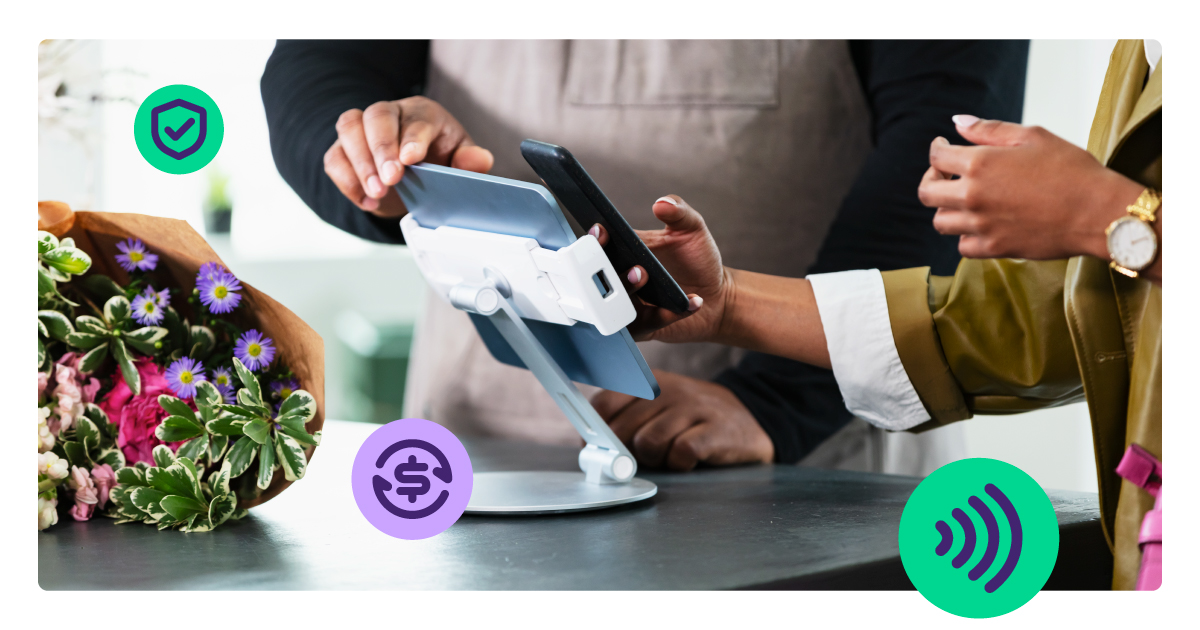Contactless payments are table stakes these days. But, dedicated contactless payment terminals are often expensive, bulky, barely portable and difficult to troubleshoot. For small businesses, those headaches have been something they have had to just put up with.
But, not anymore!
Tap to pay solutions now make it possible for merchants to accept in-person payments using their personal smartphone or tablet, nothing more. The same technology that lets a merchant tap their phone or watch to make a payment — built-in near-field communication (NFC) — now also allows them to accept tap payments. No extra hardware, no co mplication — just download an app to your phone or tablet and let customers tap.
Tap to pay offers a variety of benefits, including lower costs, increased flexibility, simplified training and more. It’s a fantastic solution for small- and medium-sized businesses (SMBs) operating on tight budgets.
Let’s look at eight key benefits of tap to pay and how they make this technology a valuable tool for you and your merchants.
1. Zero Hardware Investment
Dedicated payments hardware isn’t cheap, and the cost often puts a strain on smaller merchants. It may even dissuade some micro merchants from taking electronic payments at all. With tap to pay apps, additional hardware isn’t necessary — not even a tiny plug-in card reader. That enables SMBs to take payments directly on the devices they already own, eliminating the need to spend money on buying and maintaining hardware.
Making in-person card payments more affordable makes you a valuable partner for a variety of small merchants, including bootstrapped start-ups, micro-businesses and field sellers of all types.
2. Faster Checkout Experience
Tap to pay makes it easy for merchants to deploy checkouts anywhere. When payments no longer have to happen at the front counter, lines get shorter, checkouts become faster, and customers leave happier. Even traditionally cash-only merchants can improve the checkout experience by separating cash customers and tap customers into different lines. With convenience and speed topping the list of consumer payment expectations, tap-to-pay represents a simple, cost-effective way to offer both.
3. Broader Payment Acceptance
Tap to pay enables your merchants to accept any NFC-driven payment. That means that beyond accepting contactless payment cards, your merchants can also accept anything with a digital wallet integration. Using popular apps like Apple Pay, Google Pay and Samsung Pay, customers can tap their phones, watches or any other wearable payments tech.
For end customers, the ability to access a wider variety of payments means elevated convenience. For your merchants, it means improving the customer experience and making sales they may otherwise have lost. And, for you, it means enabling merchant success and becoming a more indispensable partner, as a result.
4. Simplified Staff Training
Rather than deal with extensive training, tap to pay enables employees to use something they’re already completely familiar and comfortable with — a smartphone. The software is designed to be as intuitive as any other app, and the interface is a large color touch screen instead of a tiny, dull LCD. That greatly reduces the time employees spend on learning the system, and it makes troubleshooting and restarting a breeze.
That also applies to next-gen terminals like the Landi M20SE, which offer smartphone-like performance to merchants looking for the simplicity of tap to pay in a non-consumer device.
5. Enhanced Security and Compliance
Smartphones have a lot of built-in security features, including advanced encryption and tamper-proof casings. When combined with tap to pay features like network tokenization, mPOC certification and full Payment Card Industry Data Security Standard (PCI DSS) compliance, a merchant’s phone becomes a locked-down payments device that offers enterprise-level security.
Not only are tap to pay apps fully PCI-compliant and fraud-resistant; they’re also less prone to physical attacks because:
- They can’t be targeted with skimmers
- The device generally stays with the merchant
- The device locks when not in use
6. Lower Maintenance and Support Costs
Specialized payments hardware is just that: specialized. When it goes on the fritz or wears out, it needs to be serviced or replaced, which takes both time and money. In the meantime, your merchants could find themselves left without a functioning payment system.
With tap to pay, there is no additional hardware to maintain or replace. Support calls are also greatly reduced because every user knows how to force stop and restart a smartphone app.
7. Improved Scalability and Flexibility
Launching a tap to pay device is easy because there’s effectively no onboarding process for new deployments. The merchant just downloads the app onto their device, enters the information you provide them and they’re ready to go. That makes tap to pay the most flexible and scalable in-person payments option on the market today.
Imagine a big sale holiday. With traditional payments hardware, if your merchant realizes they don’t have enough payment pads on the big day, it’s too late. With tap to pay, they can just grab their own smart device (or an employee’s), download the app and start taking payments on it within a few minutes. The same goes for merchants expanding to new locations, doing seasonal sales, etc. Tap to pay makes it easy for businesses to scale their payments hardware up and down as needed, with little to no planning, lead time or cost involved.
8. Native Data and Insights
Many tap to pay apps offer analytics, either built right into the app or through a web-accessible portal. That familiar medium makes it easier for merchants to interact with and understand their sales data and, in turn, to make more accurate forecasts and better decisions.
Traditional payments systems offer analytics too, but often not in the app-ified format merchants are comfortable with. Because of that, native app presentation makes data less intimidating and increases the chances merchants will put it to work.
Next Steps: Powering Your Merchants’ Smartphone Payments
As an NMI partner, you can offer a full suite of tap to pay solutions ready to serve any merchant, regardless of their size, sales environment or unique needs.
For small merchants looking to download and go, our Cloud Commerce app takes seconds to install and minutes to set up, providing you with everything you need to take contactless payments anywhere. For app developers looking for a way to build tap to pay into their software, the NMI Developer Portal and our Android and iOS SDKs make integration simple and frictionless.
To find out more about NMI Tap to Pay on Android and Tap to Pay on iPhone, reach out to a member of our team today.





